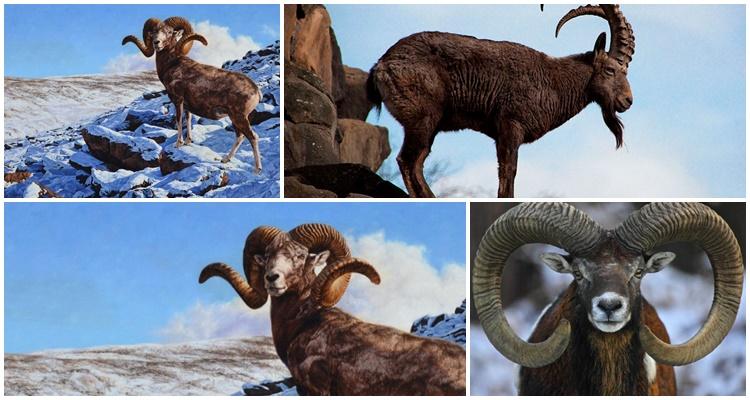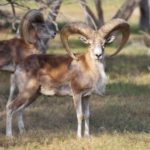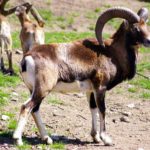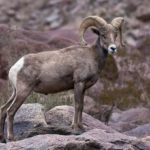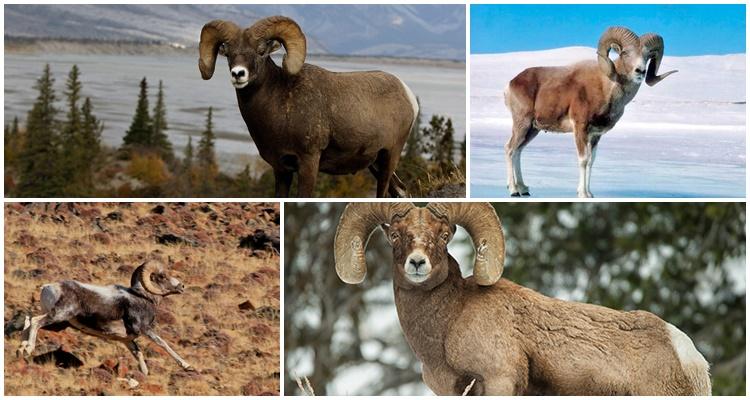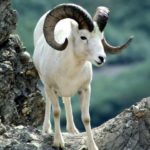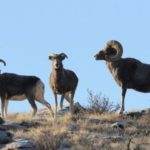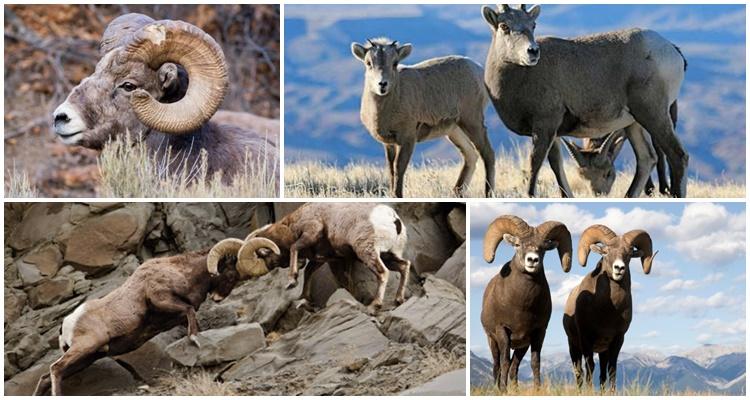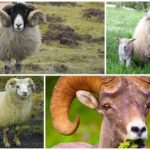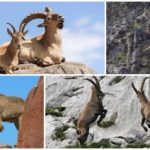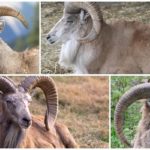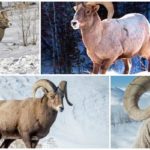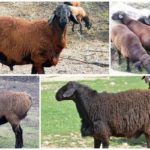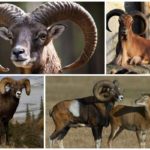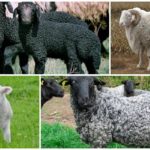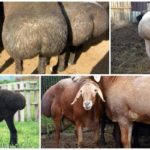Domestic sheep are related to varieties of mountain sheep. They live in the wild and are adapted to move in rocky terrain that combines cliffs and vertical slopes. Animals can be found in some areas of Eurasia, North America and the African continent. Most representatives are considered rare species.
What is the name of the mountain sheep
Mountain sheep are artiodactyl mammals that belong to the bovid family.The Latin designation of the species is Ovis ammon. According to legend, the name comes from the name of one of the gods. The inhabitants of Olympus turned into animals, fearing the giant Typhanus. And Amon took the form of a ram. Experts disagree about the classification and number of species of these animals. The term "mountain sheep" is most often used to refer to the largest representative of the group. Argali translated from Mongolian means “wild sheep”.
Origin of the species
The question of the origin of sheep has not been fully studied. Scientists are still interested in who the ancestors of animals are.
There are several types:
- Mouflons live mainly in Asia. Many researchers doubt that it was this group of animals that became the ancestor of modern species.
- Wild argali sheep are among the largest representatives of bovids. Giants are found in the foothills of Central Asia. The primogeniture of the individuals has also not been proven.
- Aragali, native to the Himalayas and Transbaikalia, is considered the most likely ancestor of sheep.
The classification system for mountain sheep is constantly changing. As a result of research, new species of artiodactyls are identified and representatives of other subspecies are combined into separate groups.
Description and characteristics
Mountain sheep are large animals with large horns that are screwed in like a corkscrew. The edges are rounded and reach a length of 1 to 2 meters. Males fight for the right to be considered the leader of the herd. And horns are formidable military weapons.
An adult ram weighs from 60 to 190 kilograms, females are 2 times lighter. The Pamir argali are considered the most impressive. This representative of the bovids is also called Marco Polo in honor of the traveler who first described the animal. The mountain sheep reaches 1.8 meters in length, but has a short tail - 10-17 centimeters.The color of artiodactyls varies from yellow to dark brown. People from the Himalayas are dark, the Russian subspecies looks much lighter. Males are distinguished by a white collar on the neck and a darker coat color compared to females. Animals molt 2 times a year.
Range and habitat
Mountain sheep are representatives of the fauna of high mountain regions. The most common areas where animals live are:
| Name | Habitat |
| Mouflons: | |
| European | One of the representatives of the European variety inhabits the south of the continent, Sardinia and Corsica |
| Asiatic | The subspecies is distributed in Asia and Transcaucasia |
| Cypriot | Rare, almost extinct species found in Cyprus |
| Argali | Representatives of this group live in Altai, Kazakhstan, Tibet and other high mountain regions. The largest ones come from the Pamir rocks. |
| Snow | These artiodactyls have chosen the expanses of Eastern Siberia |
| Thick-horned and thin-horned | Territory of residence of the species - North America |
| Urial, or steppe sheep | Lives in Central Asia and Kashmir |
Mountain sheep rarely move long distances. The migration area rarely exceeds 40 square kilometers. In the summer, the livestock rises to the alpine meadows in the mountains, in the winter they descend to the valleys, where there is less snow and it is easier to find food.
What does the animal eat?
The basis of the diet of representatives of the bovid family is grass. In high altitude conditions, sheep find space free of trees, but with varied vegetation. Ewes and young animals feed separately from males. Adults occupy territories at lower levels where significant food supplies can be found.
In elevated areas, wild sheep find various grasses and sedges, and a little lower - shrubs and mesophytes.
A valuable substance for sheep is salt, which helps replenish mineral reserves in the body. Animals also enjoy eating the branches of trees such as oaks or maples, but they consider cereals to be their greatest delicacy. The daily feed consumption rate for mature males ranges from 16 to 19 kilograms. In the mountains, small streams and melted snow become the source of water for wild sheep. In arid areas, animals sometimes have to travel long distances in search of water.
Character and lifestyle of the ram
Mountain sheep are rarely found alone; the animals often form small herds. Ewes and their offspring live in groups separate from adult males. Migration is usually associated with the search for food. During the hot season, artiodactyls move closer to the top of the mountain.
Mountain sheep are smart. They warn their relatives about danger with a low bleating sound. They try to avoid direct collision with enemies. The ability to jump from one rock to another helps to escape from predators. The animal jumps in length at a distance of 3-5 meters. In situations that do not pose a threat to life, wild animals demonstrate a peaceful disposition.
Social structure and reproduction
The rut of mountain sheep begins in mid-autumn and lasts until January inclusive. In animals living at lower elevation levels, this period is sometimes longer. Adult rams stage a real battle for the right to mate with a female. The blows of the horns they exchange can be heard at a distance of about 800 meters.The winner chooses the female.
Females reach sexual maturity at 2 years, much earlier than males, who begin to mate with the opposite sex no earlier than 5 years. Wild rams stay close to their chosen one for another 2 months after the rut. The gestation period reaches approximately 165 days. Typically due dates fall in March or April.
Main characteristics of animal formation:
| Indicators | Meaning |
| Lambs birth weight | up to 5 kg |
| Weight gain in the first days after birth | tenfold |
| The appearance of the first milk tooth in lambs | in 3 months |
| Final formation of teeth | in 6 months |
| Age of maximum weight gain: | |
| in females | 2 years |
| in males | 4 years |
| Lifespan | 10-12 years |
1 lamb usually produces 1 lamb. Some species of bovids give birth to twins, and sometimes cases of five lambs being born at once are recorded. Females continue to feed their offspring with milk even after teeth appear.
Natural enemies of mountain sheep
Artiodactyls do not avoid other animals. When mountain sheep stick together, their horns and fast running serve as protection from danger. But if an individual is left alone, it freezes in place until the threat passes.
The ability to move over rocky terrain serves as reliable protection against predators. Artiodactyls can become victims of wolves. They are also hunted by leopards, leopards and other representatives of the cat family, and small animals by golden eagles and eagles.
Population and species status
The number of mountain sheep has decreased in recent years. Some species are in danger of complete extinction. Predators are not the only ones that influence population decline.Poachers have long been attracted to luxurious animal horns, skins and meat. Bans on the sale of valuable raw materials do not deter traders of underground goods. Artiodactyls are shot even in territories under state protection. In China, ram horns are used in folk medicine. In Russia, the decline in population is influenced by mining, in Mongolia - by the development of agriculture. Urbanization processes lead to a decrease in rare animals in many countries.
Problems of species conservation
Mountain sheep are included in the Red Book of Russia, China, Kazakhstan and other countries. Nature reserves are being created in different parts of the world where rare animals are caught only for breeding. In zoos, artiodactyls are kept in spacious pens, which have a separate room for protection from bad weather. Comfortable conditions help the herd easily adapt to captivity.
The appearance of offspring outside the wild environment gives hope for population restoration. Domesticated animals are also crossed with domestic sheep, which contributes to the emergence of new breeds.

